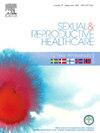Emotional health across the perinatal period: Longitudinal patterns of fear of birth and depressive symptoms in a midwifery continuity of care context
IF 1.7
3区 医学
Q3 PUBLIC, ENVIRONMENTAL & OCCUPATIONAL HEALTH
引用次数: 0
Abstract
Objectives
Perinatal depressive symptoms affect both maternal and infant well-being and are associated with fear of giving birth. Midwifery continuity of care (MCoC) has shown potential in reducing anxiety and depression, particularly among vulnerable women. The aim of this study was to explore the trajectories of fear of birth and depressive symptoms, in relation to background, attitudes and birth-related data.
Methods
A prospective longitudinal study was conducted among women with fear of birth or depressive symptoms who, after a screening procedure were offered care in a MCoC model. Fear of birth and depressive symptoms were assessed with the Fear of Birth Scale (FOBS) and Edinburgh Postnatal Depression Scale (EPDS) and measured at screening, in mid pregnancy and twice after birth. Chi-square tests and analysis of variance were used for comparing groups.
Results
The questionnaires were completed by 175 women during pregnancy and by 140 postpartum. During screening 84% presented with fear of birth and 24% with depressive symptoms. The degree of fear of birth and the depressive symptoms changed over time with the highest prevalence during pregnancy and a decline after birth. The trajectory of depressive symptoms was mainly related to women’s attitudes, while birth-related variables concerned fear of birth.
Conclusion
This study showed that fear of birth as well as depressive symptoms changed over time. These changes may represent natural progression but might be associated with the intervention. Working with women’s attitudes might change the trajectories, especially in women with both fear of birth and depressive symptoms.
整个围产期的情绪健康:在助产护理的连续性背景下,出生恐惧和抑郁症状的纵向模式
目的围产期抑郁症状影响母亲和婴儿的健康,并与分娩恐惧有关。助产护理连续性(MCoC)已显示出减少焦虑和抑郁的潜力,特别是在弱势妇女中。本研究的目的是探讨出生恐惧和抑郁症状的轨迹,与背景、态度和出生相关数据的关系。方法对有生育恐惧或抑郁症状的妇女进行前瞻性纵向研究,在筛选程序后,在MCoC模型中提供护理。用出生恐惧量表(FOBS)和爱丁堡产后抑郁量表(EPDS)评估出生恐惧和抑郁症状,并在筛查、妊娠中期和出生后两次进行测量。组间比较采用卡方检验和方差分析。结果175名孕期妇女和140名产后妇女分别完成了问卷调查。在筛查期间,84%的人表现出出生恐惧,24%的人表现出抑郁症状。出生恐惧程度和抑郁症状随时间变化,怀孕期间患病率最高,出生后下降。抑郁症状的发展轨迹主要与妇女的态度有关,而与出生有关的变量则与对出生的恐惧有关。结论出生恐惧和抑郁症状随时间的变化而变化。这些变化可能代表自然进展,但可能与干预有关。改变妇女的态度可能会改变这一轨迹,尤其是那些既害怕生育又有抑郁症状的妇女。
本文章由计算机程序翻译,如有差异,请以英文原文为准。
求助全文
约1分钟内获得全文
求助全文
来源期刊

Sexual & Reproductive Healthcare
PUBLIC, ENVIRONMENTAL & OCCUPATIONAL HEALTH-
CiteScore
2.70
自引率
5.60%
发文量
73
审稿时长
45 days
 求助内容:
求助内容: 应助结果提醒方式:
应助结果提醒方式:


